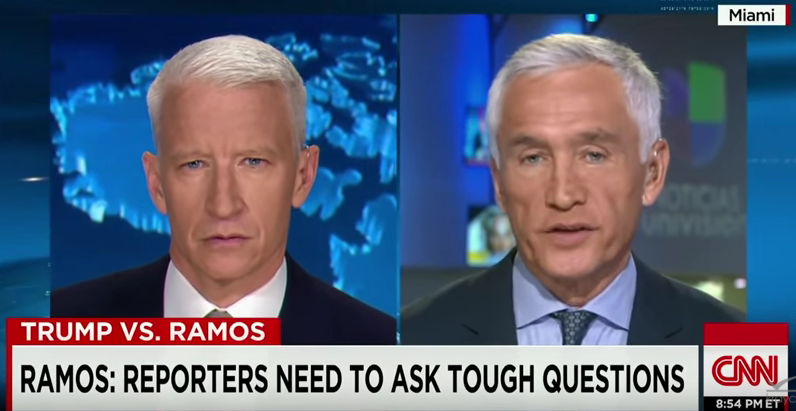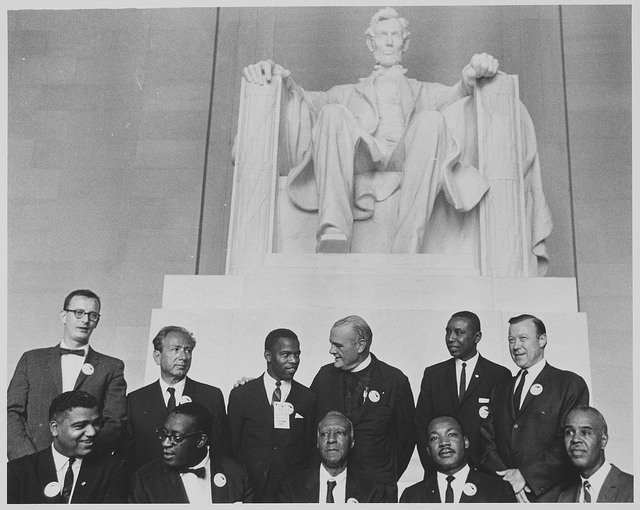by Meagan Doll & Steven Wang, CJE fellows
“What is often a winner is a story that the audience largely finds familiar with perhaps a palatable twist in it,” Mascall-Dare said. “What I found is that if I go into a story with a framing strategy that my audience finds very comforting and that basically fits the grand narrative, and then I smuggle in the new, interesting, controversial, challenging stuff, they can better go along with it.”
Events like this week’s Martin Luther King Jr. Day bring a predictable onslaught of anniversary and remembrance stories.
The events of the past are memorialized, recreated and retold in the age-old practice of the anniversary story.
“Though the stories are about the past, we are building memories for the future generations,” said Carolyn Kitch, a journalism professor at Temple University.
But, there’s an ethical problem with accepting the truth that’s been told before as the only version of the truth.
Re-purposing the same narrative year after year can reinforce the marginalization of previously unheard voices, said Gregory Favre, a former executive editor of the Sacramento Bee and vice president for McClatchy Newspapers.
Journalists have ethical responsibilities to both their audiences and people who lived the events to dig deeper, Kitch said.
 Today, journalists and scholars need to do more to analyze how anniversary news stories can perpetuate stereotypes, said independent journalist and media ethics scholar Sharon Mascall-Dare.
Today, journalists and scholars need to do more to analyze how anniversary news stories can perpetuate stereotypes, said independent journalist and media ethics scholar Sharon Mascall-Dare.
“When we’re thinking about journalism in the context of racialized anniversary stories where journalists have to interrogate narratives and think carefully about how stories are told and the shaping of collective memory and the ethical responsibility that goes with telling that story well and accurately.”
WHOSE HISTORY?
For those who believe journalism to be a first draft of history, anniversary stories provide a second (or 100th) opportunity to explore, amend and reinforce collective memory associated with high-profile events.
Stephen Ward, a media ethicist now based in Madison, Wisconsin, said it is difficult for journalists to construct an accurate memory.
But, particularly when these anniversary stories have an element of race, the collective memory may not be accurate. Ward said reporters and audiences default to subtle biases that are particularly problematic when the coverage is about minority groups.
“We accept certain narratives,” Ward said. History as told in news coverage tends to reinforce the established mainstream view, or a white man view regarding stories including racial minorities.
Anniversary reporting amplifies a certain social memory because journalists spread one version of the events to those who aren’t eyewitnesses, she said.
“Social memory is about the public constructing shared meanings,” Kitch said.
Journalists should also be sensitive to ideologies embedded in stories commemorating historical events, Ward added. Anniversary reporting of events like Sept. 11 attacks and D-Day can easily take on a patriotic perspective.
For example, anniversary coverage of Sept. 11 generally emphasizes patriots and heroic events, while downplaying the ethic discrimination toward “the enemies,” Ward said.
WHOSE STORY?
Favre, who in addition to working for the Bee and McClatchy wrote about remembering Hurricane Katrina for Poynter, said said anniversary stories play a part in preventing similar tragedies to those which are often commemorated.
“The function of anniversary stories is to rekindle memories, of course” he said. “But it is also to make sure people don’t forget – if things can be prevented in the future, perhaps this is another step to prevention.”
But even the decision about which stories to retell is made without marginalized voices in mind.
Mascall-Dare, who is based Adelaide, South Australia, said there has been a historic focus on reader figures, influencing whose stories are magnified.
Editors and journalists choose to commemorate with news coverage the stories and events they think will attract the largest audience.
“Often, reader figures, click figures, listener figures come first,” she said.
Mascall-Dare said the consequence of this reality is that the stories of racial minorities often go unheard.
She points to a national day of remembrance for military veterans in Australia and New Zealand as an example. The day was originally created to specifically honor the members of the Australian and New Zealand Army Corps who fought at Gallipoli against the Ottoman Empire during World War I.
“The Anzac story has essentially become a national defining narrative,” Mascall-Dare said. “And race comes into that narrative because [ANZAC Day] tends to be dominated very much by a narrative that privileges an image of the iconic anglo-saxon Australian soldier, to the exclusion of indigenous soldiers and other migrant nationalities.”
While Mascall-Dare’s research challenges racial inequities present in some anniversary stories, she also warned that journalists must proceed with caution when writing about pre-conceived racialized stories.
Journalism, which counts conflict among its central news values, will often highlight the controversy of racial diversity as a storytelling technique, Mascall-Dare said. Reporters can tell more accurate stories by listening to sources rather than inserting their own narrative, she said.
“It’s important when engaging with people in a cross-cultural context that we allow the people we’re engaging with to set their own terms about what they do or don’t think is appropriate and to decide whether the subject matter is even race related,” she said. “Sometimes a story that may have a race connection may turn out that race is not even the crux of it.”
WHAT ANGLE?
Embed from Getty Images
When journalists set out to report an anniversary story, they often begin by returning to the breaking news published at the time of the event, said Kitch. Kitch, who is also chairwoman of Journalism and Mass Communication at Temple’s School of Media and Communication, has long focused her research on journalism history and public memory.
“Try to put a fresh face on stories,” Favre said. “The problem is some people just recycle the same old, same old and that doesn’t advance those stories or look at them in a different way.”
Bringing in minority voices is a delicate balance, Mascall-Dare said, admitting that the odds may feel against those trying to challenge the dominant narrative.
“You’ve got to be very strategic about how you go about it as a communicator,” she added.
Favre said he tries to make anniversary stories into contemporary reflections.
“I always like to look forward. Where are we now? What has taken place to make sure the levees won’t break again in New Orleans?” he said. “Looking back doesn’t always serve your reader well.”
Ward said a self-indulgent sentiment is the first thing to avoid. The interpretation of past events should have a critical emphasis on their social impacts, he said.
The focus should be about how audiences can understand the present problems better by looking back at them. Mascall-Dare had similar advice for journalists: Adopt a challenging perspective within a largely familiar story.
What is often a winner is a story that the audience largely finds familiar with perhaps a palatable twist in it,” she said. “What I found is that if I go into a story with a framing strategy that my audience finds very comforting and that basically fits the grand narrative, and then I smuggle in the new, interesting, controversial, challenging stuff, they can better go along with it.”
WHAT NEXT?
Mascall-Dare said anniversary stories can add depth to simplistic grand views of history.
“The beauty is that by exploring other perspectives which might be seen as alternative or irrelevant or confusing, surely that’s where you can add to the richness of understanding around that event,” she said. “You can aspire to a far more inclusive and socially and ethically responsible representation when you’re not privileging some voices over others or marginalizing particular perspectives.”

Moving toward these goals, Mascall-Dare encouraged journalists to do their part to teach and not simply entertain.
“I would argue that this is where journalists need to think about their role as not just feeding a hungry animal,” she said. “In order to challenge audience perspectives and bring them onside with new and alternatives ways of thinking about that narrative, you do need to be prepared to step into that role of an educator.”
Favre encouraged journalists to do more than rehash the past.
This can involve telling people “what they don’t necessarily want to hear,” Favre said, suggesting that journalist can become too dependent on entertainment value and audience statistics.
Kitch said journalists should lead public attention to work still needed to be done and provide the political and economic context for racial inequality.
Ward suggested a more-diverse newsroom as solution to combat racial inequities especially.
“You need people who really understand the culture,” he said. “You’ve got to take time and effort to know those people, without taking out your threatening notepads at first.”
Mascall-Dare added that change can begin with one’s own moral conscience, encouraging journalists to call out unethical reporting in the newsroom.
“For any young journalist in the profession today, that’s what they need to be aspiring to – brave, courageous, outspoken, challenging, confronting journalism,” she said. “If we’ve gone into the job for the right reason, you should have no qualms about standing up and calling out cliche or unethical reporting when you see it. At the end as journalists, isn’t that what we’re all meant to do?”
This story is one in an occasional series about Race, Ethnicity and Journalism Ethics. These stories will culminate in the center’s annual conference April 29.








